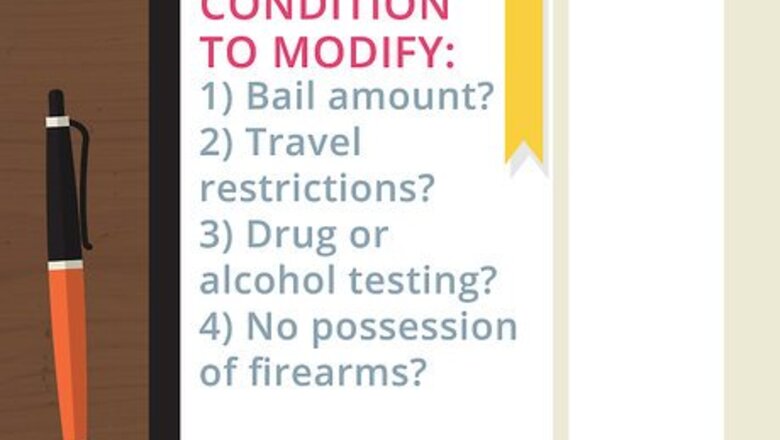
views
Drafting the Motion
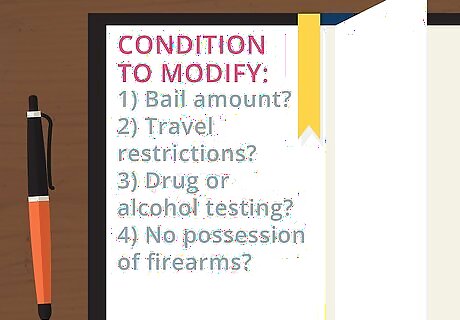
Identify which condition you want to modify. The judge may have imposed many conditions as part of your bail. You should identify all of the conditions you want to modify so that you can ask the judge in one motion for a modification. Common conditions include: The amount of bail. If you want to reduce your bail, then see Get Bail Reduced. This article will deal with modifying other conditions. Travel restrictions. You might be prohibited from leaving the state or county. No contact restrictions. You could also be restricted from contacting an alleged victim or a witness. Drug or alcohol testing. You may need to take periodic drug tests, especially if your crime involved using drugs. No possession of firearms.
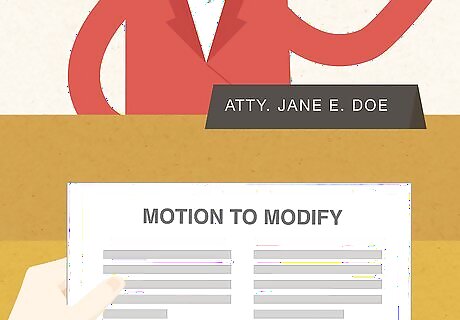
Tell your lawyer to file the motion. As a criminal defendant, you should have a lawyer. If you couldn’t afford a lawyer, then you should have applied for a public defender. Sometimes bail is set at the initial appearance, before you have had a chance to get a lawyer. If that happened, then you should hire one. Tell the lawyer as soon as you hire him or her what condition of your release you want to modify. Your lawyer should get to work right away drafting a motion to modify the conditions of your release.
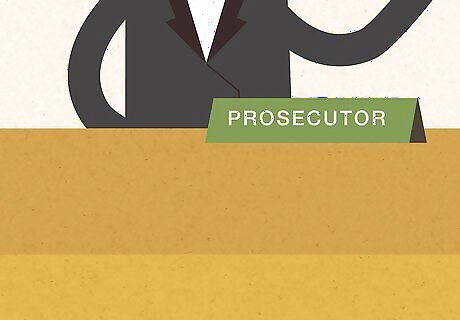
Talk with the prosecutor. The prosecutor might agree to the proposed change. If so, then you have a much stronger argument and can mention that fact in your motion. Talk to the prosecutor by calling or visiting. Make sure you have a good argument for why you want to change the condition of your release. For example, you might need to leave the county in order to perform your job. That is a much stronger argument than claiming you want to leave just for a vacation.
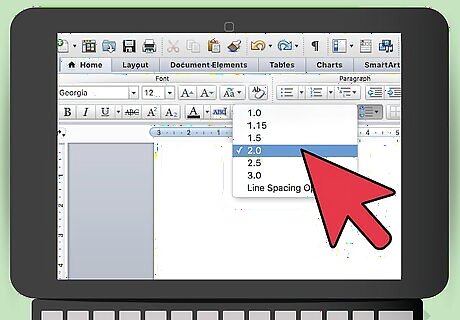
Format your motion. You should type your motion so that it is easy to read. Open a blank word processing document. Set the font to 14 point Times New Roman or Arial font. Also make sure that the document is double-spaced and that you have one-inch margins. Also look at other documents filed in your case, such as the criminal complaint. Check if it was printed on “pleading paper,” which is paper numbered up the left-hand side. You can download this kind of paper from online.
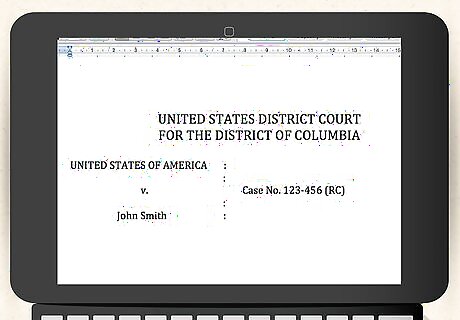
Insert the caption. The top of the first page should contain the “caption.” This information stays the same throughout the entire case. You can find this information by looking at any document filed in your case so far. The caption includes: The name of the court. The government prosecuting you, such as “People of Maryland” or “United States.” Your name as the defendant. The case number.
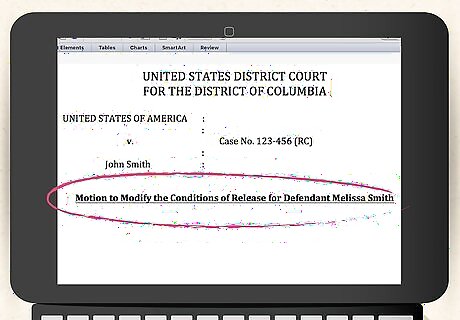
Title your motion. You can title it “Motion to Modify the Conditions of Release for Defendant Melissa Smith” or something equivalent. Make sure to put your title in all caps and underline it. You can also make the lettering bold, so that the title stands out.
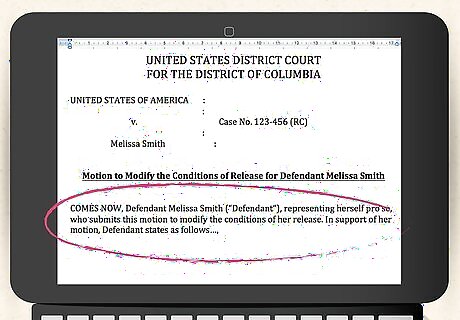
Add an introduction. You should introduce yourself in the introduction and also state whether you have an attorney or if you are representing yourself (called representing yourself “pro se”). You should also tell the judge why you are bringing the motion. Sample language could read: “COMES NOW, Defendant Melissa Smith (“Defendant”), representing herself pro se, who submits this motion to modify the conditions of her release. In support of her motion, Defendant states as follows….”
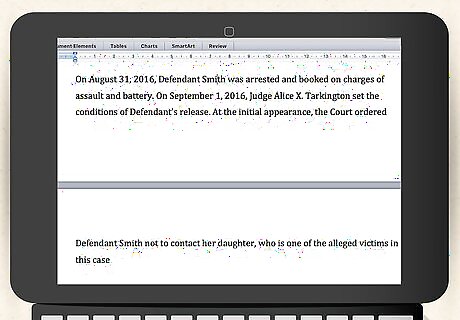
Provide important background facts. You should spend the first few paragraphs giving the judge some important background information. For example, you should include the date you were given your initial bail. If you hired a lawyer, you can also state that you’ve retained counsel and identify who they are. You could write, “On August 31, 2016, Defendant Smith was arrested and booked on charges of assault and battery. On September 1, 2016, Judge Alice X. Tarkington set the conditions of Defendant’s release. At the initial appearance, the Court ordered Defendant Smith not to contact her daughter, who is one of the alleged victims in this case.”
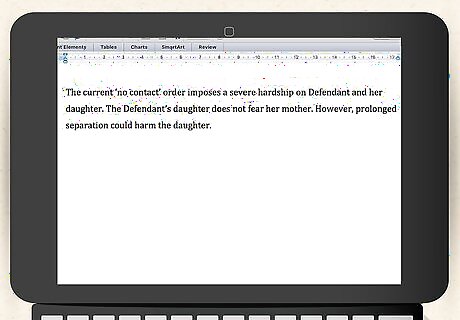
Ask to modify the conditions of release. You need to explicitly ask the court to modify the conditions of release and explain how they should be modified. You should also provide reasons why the conditions should be modified. For example, you could argue that the conditions impose an undue hardship on you. For example: “The current ‘no contact’ order imposes a severe hardship on Defendant and her daughter. The Defendant’s daughter does not fear her mother. However, prolonged separation could harm the daughter.” If you want to stop having to take drug tests, you should mention that you have passed every test so far. For example: “While on release, Defendant has tested negative for all banned substances every time she has been tested. Because Defendant has no history of drug use, she requests that this Court rescind drug testing as a condition of her release.” If the prosecutor has agreed with you that the conditions should be modified, then be sure to mention that fact. For example: “Counsel for the United States and Defendant have discussed this issue. The United States has agreed not to contest this motion.”
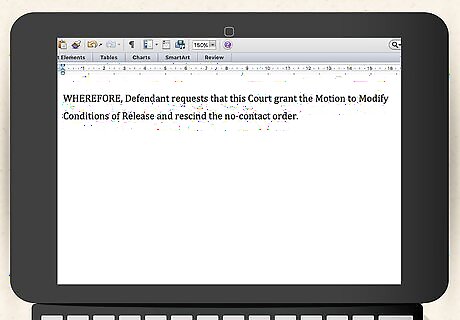
Add a conclusion. At the end of the motion, you should briefly repeat what you want the judge to do. Also remember to sign and date your motion. All motions submitted to a court must be signed. Your conclusion could read: “WHEREFORE, Defendant requests that this Court grant the Motion to Modify Conditions of Release and rescind the no-contact order.”
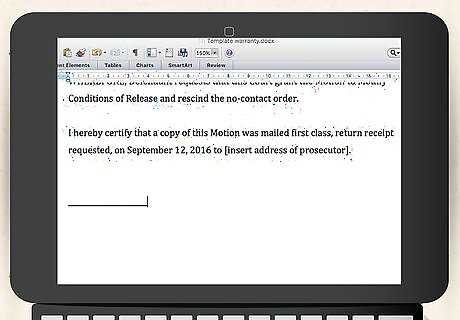
Draft a certificate of service. You need to provide the prosecutor with a copy of your motion so that they can object. Even if they don’t object, you should still give them a copy. You can add a certificate of service to your motion, which certifies how you provided notice. The certificate could read: “I hereby certify that a copy of this Motion was mailed first class, return receipt requested, on September 12, 2016 to [insert address of prosecutor].” Then include a signature line and sign it. If you are trying to rescind a no-contact order, then the victim the order applies to should also be given a copy. They need to agree that the no-contact order should be rescinded.
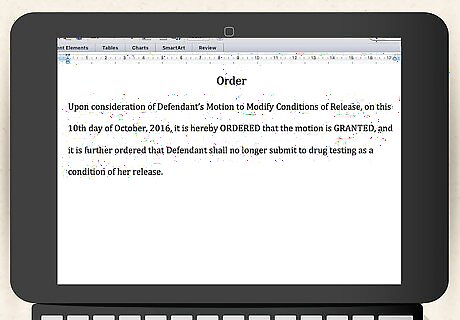
Include a proposed order. Many courts require that you submit a proposed order. The order is what the judge signs if you win the motion. You should draft it on a separate sheet of paper. You should insert the caption information at the top and title it “Order.” The body of the order will depend on what you are asking for. For example, if you are asking that the judge rescind the requirement for drug testing, then the order could read: “Upon consideration of Defendant’s Motion to Modify Conditions of Release, on this 10th day of October, 2016, it is hereby ORDERED that the motion is GRANTED, and it is further ordered that Defendant shall no longer submit to drug testing as a condition of her release.” Then include a line for the judge’s signature.
Filing the Motion
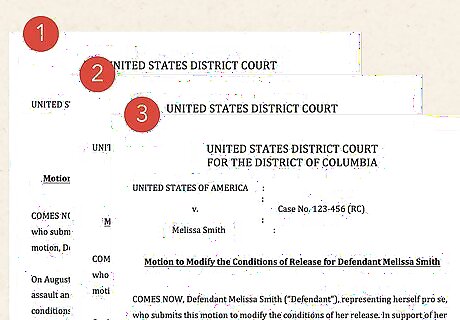
Make several copies. You should make one copy for your records and another copy to send to the prosecutor. Your court may also require that you file copies along with the original. Ask the court clerk how many copies you need to file.
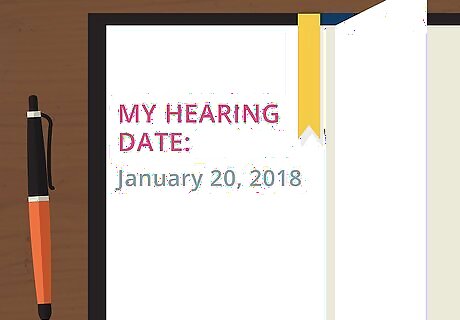
Get a hearing date. You need to schedule a day and time for the judge to hear argument on the motion. Each court handles scheduling a little differently. In some courts, the clerk will schedule the hearing after receiving your motion and will notify all parties of the date. In other courts, you have to ask the clerk for a hearing date and then fill out a Notice of Hearing form and send it to the prosecutor.
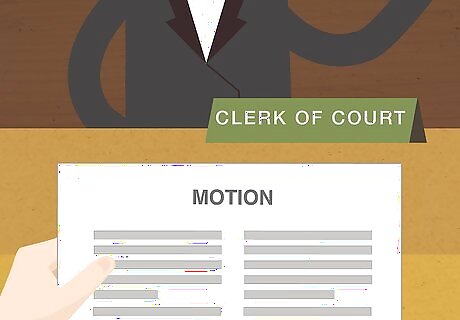
File your motion with the clerk. Take your copies and original to the clerk. Ask to file. He or she can stamp your copies with the filing date. If you are still in jail, then you will need to mail the motion to the court. Ask someone in the jail for the address. You may have to pay a filing fee to file a motion. Ask the court clerk for the amount and acceptable methods of payment.
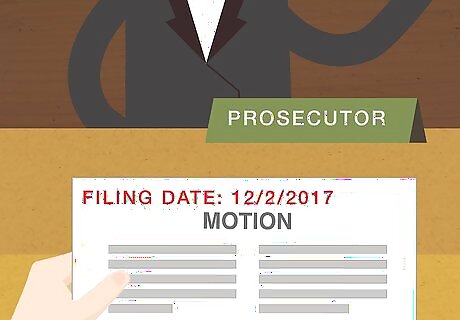
Send a copy to the prosecutor. Use the method identified in your certificate of service. If you had someone hand deliver the motion, then ask the server to fill out a “proof of service” or “affidavit of service” form, which you can get from your court clerk. The server should return the signed affidavit to you. Keep a copy and file the original with the court.
Attending a Hearing
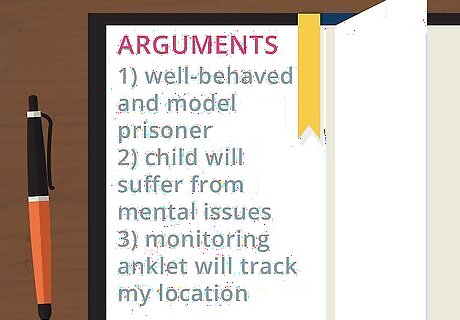
Prepare your argument. Your argument should be based on the factors the judge considers when determining bail conditions. In particular, the judge wants to feel confident that you aren’t a flight risk or a danger to the community. Make a list of bullet points and try to hit your most important arguments. You probably won’t have a lot of time to argue in front of the judge. If you are nervous, then you can sit in on a day when the judge has a hearing. Check the judge’s calendar, which may be online, or call the judge’s clerk and ask when motions are heard.

Dress appropriately. You want to create a good impression on the judge. For this reason, you should spend some time putting together a good wardrobe. You want to convince the judge that you are responsible and that modifying your conditions of release won’t endanger the public or your alleged victim. The more professional you look, the better. Men can wear business pants and a button-up shirt with a collar. Wear a conservative tie if you have one. Conservative ties are in neutral colors (not pink or neon green) and are a solid color or with a check pattern. Remember to wear dress shoes with dark socks and shave or trim your beard. Women have more options. Generally, women can wear a skirt or dress pants with a nice sweater or blouse. Women can also wear conservative dresses. Fit is most important. Don’t wear anything too tight or revealing. Women should also wear shoes, not sandals. Neither men nor women should wear shorts, jeans, T-shirts, flip-flops, ball caps, or clothing that has writing on it.

Make your argument. When it is your time to argue, the clerk will call your name. Say “Here!” and then move to the front of the courtroom. As you make your argument, remember the following tips: Talk only to the judge, not to the prosecutor. Speak loud enough so that you can be heard. Call the judge “Your Honor.” Don’t interrupt the judge. If the judge has questions, listen quietly to the question and answer it directly.
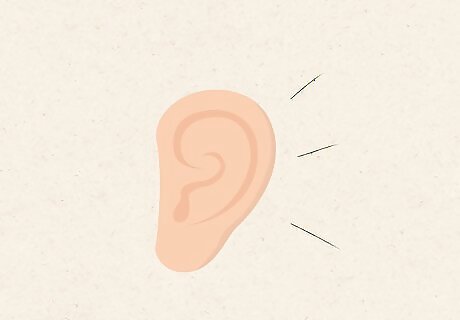
Listen quietly to the prosecutor. If the prosecutor opposes your motion, then he or she will show up and argue that the judge shouldn’t modify your conditions of release. You can’t interrupt the prosecutor as he or she argues. Don’t raise your hand—the judge will give you a chance to respond when the prosecutor finishes. Write down anything you want to respond to. When the prosecutor finishes, ask the judge, “Your Honor. May I respond?”

Have the victim speak. If you are trying to rescind a no-contact order, then the court may require that the victim come into court and state why he or she agrees to rescind the order. In many states, the judge won’t agree to rescind the no-contact order unless the victim can give compelling reasons for doing so.
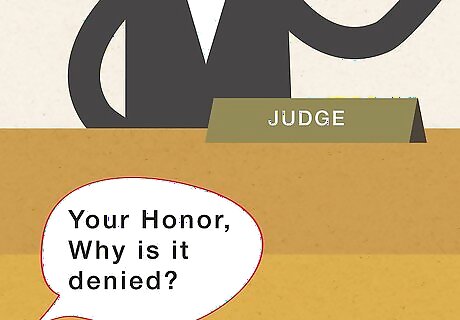
Ask the judge to explain the reasons for denying your motion. If you lost the motion, then you will want the judge to explain why. In most state courts, judges don’t draft written opinions when they deny motions. Instead, they give their reasons from the bench orally. Accordingly, if you lose, then ask the judge to explain the reasons. The court reporter will take down whatever the judge says. If the judge agrees with you, then he or she should sign your order.




















Comments
0 comment